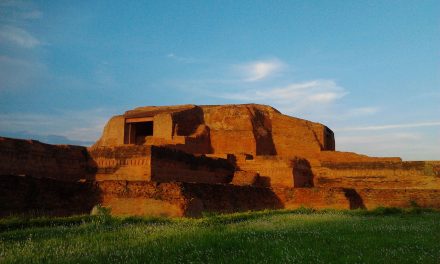Praṇava (प्रणव) – ॐ holds a position of paramount importance in Dharma.
It is the sacred sound that has become the primary spiritual symbol of Dharmic traditions, over millenia, having been chanted either independently or before a spiritual recitation in Hinduism, Jainism and Buddhism. It is also holds a special position for me, personally, having been ubiquitous in my spiritual pursuits and meditation. Through more than three millennia of religious practices, linguistic explorations and application in spirituality in the Vaidika Dharma, Om became a sacred syllable. It can be regarded as much as the sonic essence of the Vedas as a audible realization of the supreme cosmic principle of Brahman in Hinduism.
Om has had an interesting historical journey. We do not find any reference to Om in the Rig Veda, although the doctrines of Akṣara and Vāc -that are later associated with Om– are seen. The sound Hiṃ, which is seen in the Rig Veda, is regarded by some as a proto-Om, if you will. The oldest occurrence of Om can be seen in form of Stobhas (chanted interjections in a Sāman – Vedic song or tune) in the Samaveda Samhitas, composed around 1000 BCE. Om is also seen, in an early form, in the Yajurveda Samhitas in the mantras of Vājasaneyins and Maitrāyaṇīyas. In the Brāhmaṇas, Om is seen to emerge from the extraction of meaning and the essence of Vedas by Prajāpati. While the phonological equation: Om = A+U+M and Om as ‘yes’ is attested by Aitareyins of the Rig Veda, reflections by Jaiminīyas of Samaveda on Om led to a gradual integration of the sacred sound into doctrines of Brahman, Vāc and Akṣara. This is also seen in the Aranyakas, wherein the Jaiminīyas wrote on their reflections on Om, bringing in the idea of an ‘unexpressed’ (Anirukta) song and the general Jaiminīya soteriology of a song, when speaking of Om.

It was in the Upanishads that Om had an associated contemplative soteriology, with the usage or contemplation being independent of any specific ritual context. There was also a pan-Vedic discourse on the sacred syllable constructed. There are introspective, renunciatory and devotional practices that begin to be associated with Om. In all this, there were ancient theological and religious tussles between, and stages of evolution facilitated by, different schools of theologians on Om. For instance, while the Jaiminīyas individuated Om as the essential, foremost of syllables of the Vedas, the Kauthumas transcended its sacrificial context using metaphysical speculations that led to a new contemplative soteriology. An important point to note in all this is the sonality of syllable. At the end of the day, Om is a sound that appears in multiple forms in Shlokas, Mantras, songs and recitations. It is interesting to note that in Śrauta traditions, Om has more than 20 distinct and discrete archetypal uses and takes many forms: sounds o, om̐, om, o3m, o3 (with the number ‘3’ here denoting trimatra or syllabic spaces/lengths) and oṃ all come under the rubric of Om.
The sonality and multiformity of Om are its salient features.
In being so, Om is a manifestation not only of Śabdabrahman but also of Brahman as the infinitely creative cosmic principle, that infuses all forms and yet is beyond it. This is also the reason, Om can be used to bridge various terms in mantras and shlokas. There is also a cosmogonic aspect to Om, where Prajāpati is unable to extract the essence of Om thereby showing the irreducibility of the sacred syllable (albeit there is a later expansion in the Upanishad with A+U+M). More importantly,
Om holds the place for all that remains unexpressed (albeit with the potential for expansion and expression), and in doing so, is itself inexpressible.
In Vedic texts, Om can convey various meanings and textual sections some of which may not describable or expressible. In doing so, Om maintains its applicability as an expression of the Supreme Principle – Brahman, which is itself inexpressible. The extent of its possible reducibility and expressibility starts and stops with the expression Om and its sonality. The idea of the whole in one – ‘this whole world’ (Idam̐ Sarvam) is an apt description of Om as well as Brahman, going by scriptural and spiritual evidences. A key understanding in this is that ritual performance, be it ṛc (a stanza of typically 3-4 padas with each pada usually being generally of 8, 11 or 12 syllables), sāman (a song) or yajus (a sacrificial prayer or formula), by themselves, do not shield a man from spiritual ignorance and these rituals must be informed by knowledge of the esoteric essence of the Veda encapsulated in the single sacred syllable: Om. The salvific efficacy and potency of Om lies in contemplating it as much, if not more than, the one who sings it.
In this article, while these nuances give us primary aspects of Om, I will now share those aspects of Om arising out of spiritual realisation and pursuits, and not just intellectual or theological explorations. The words ‘Om Tat Sat‘, enshrined in the Srimad Bhagavad Gita, is not completely understood till it is experienced that once all dualities, binaries and multiplicities cease to exist, only Om remains. In being so, Om is not just the essence of existence.
Om is existence itself.
Om is a resonance that is distinct, having no origin. This is something that I found in my experience of unity consciousness at the age of 24, when Om resounded when there was nothing else remaining, as distinct, by the banks of the River Cam. Everything was one but suffused with this quiet sound and calm vibration, oxymoronic as those are. Physically, the fact that everything arises out of perturbations and vibrations of underlying fields is an active avenue of research in Quantum Field Theory (QFT) and Physics today. Vedic seers always believed that the Universe was a manifestation of an underlying sonic reality, which can be restructured as a vibratory one. While this is still speculative, the experienced remains, as also attested by various spiritual luminaries. Since sound is usually formed by pressure waves (crests and troughs in density of medium-particles) and usually by the impact of two bodies/elements, the existence of Om when complete dissolution takes place while experiencing unity consciousness means this sound is ‘Anahata‘ or unstruck, as has been described to be so in Vedic texts.

In this unity, there is a palpitating field that remains in one’s perception that has a tendency of interactions and self-interactions at each point. And yet, there is a calm that arises out of the complete absence of binaries, dualities and multiplicities. This is beyond just happiness that arises out of the presence of an element or cause of joy or the absence of a cause of pain and/or grief. When there are no elements whatsoever, this bliss attained with unity consciousness is an equilibrium, a bliss that transcends temporality and physicality. Therefore, one can say
Om is the syllabic representation of pure consciousness and a provider of Ananda (bliss)
Therefore, one can directly experience the reality of the identification of Om with Brahman that is described as sat-chit-ananda (existence-consciousness-bliss) and need not just read about this or the very many definitions, interpretations and readings of what Om means. I feel this is the best way to address one’s inner desire and drive for knowing the Truth, the reality of the Universe, of life and existence itself, without any crutches of ideological constructs, philosophical tomes and intellectual cartwheels. And in doing so, naturally one can realise the meaning of Praṇava (प्रणवार्थ) of the Vedic heritage.
Meditate on Om. Experience Om. Experience Brahman.
















